Widespread translational control contributes to the regulation of Arabidopsis photomorphogenesis
- PMID: 22252389
- PMCID: PMC3296358
- DOI: 10.1038/msb.2011.97
Widespread translational control contributes to the regulation of Arabidopsis photomorphogenesis
Abstract
Environmental 'light' has a vital role in regulating plant growth and development. Transcriptomic profiling has been widely used to examine how light regulates mRNA levels on a genome-wide scale, but the global role of translational regulation in the response to light is unknown. Through a transcriptomic comparison of steady-state and polysome-bound mRNAs, we reveal a clear impact of translational control on thousands of genes, in addition to transcriptomic changes, during photomorphogenesis. Genes encoding ribosomal protein are preferentially regulated at the translational level, which possibly contributes to the enhanced translation efficiency. We also reveal that mRNAs regulated at the translational level share characteristics of longer half-lives and shorter cDNA length, and that transcripts with a cis-element, TAGGGTTT, in their 5' untranslated region have higher translatability. We report a previously neglected aspect of gene expression regulation during Arabidopsis photomorphogenesis. The identities and molecular signatures associated with mRNAs regulated at the translational level also offer new directions for mechanistic studies of light-triggered translational enhancement in Arabidopsis.
Conflict of interest statement
The authors declare that they have no conflict of interest.
Figures


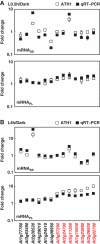
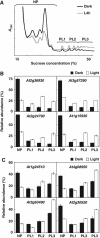
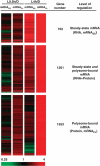
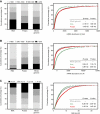
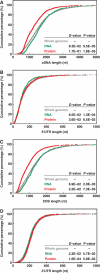


Similar articles
-
Translational landscape of photomorphogenic Arabidopsis.Plant Cell. 2013 Oct;25(10):3699-710. doi: 10.1105/tpc.113.114769. Epub 2013 Oct 31. Plant Cell. 2013. PMID: 24179124 Free PMC article.
-
Increased sucrose levels mediate selective mRNA translation in Arabidopsis.BMC Plant Biol. 2014 Nov 18;14:306. doi: 10.1186/s12870-014-0306-3. BMC Plant Biol. 2014. PMID: 25403240 Free PMC article.
-
Processing bodies control the selective translation for optimal development of Arabidopsis young seedlings.Proc Natl Acad Sci U S A. 2019 Mar 26;116(13):6451-6456. doi: 10.1073/pnas.1900084116. Epub 2019 Mar 8. Proc Natl Acad Sci U S A. 2019. PMID: 30850529 Free PMC article.
-
Gene expression regulation in photomorphogenesis from the perspective of the central dogma.Annu Rev Plant Biol. 2014;65:311-33. doi: 10.1146/annurev-arplant-050213-040337. Annu Rev Plant Biol. 2014. PMID: 24779996 Review.
-
Genes controlling Arabidopsis photomorphogenesis.Biochem Soc Symp. 1994;60:257-63. Biochem Soc Symp. 1994. PMID: 7639785 Review. No abstract available.
Cited by
-
Photosynthetic gene expression in higher plants.Photosynth Res. 2013 Nov;117(1-3):91-120. doi: 10.1007/s11120-013-9880-8. Epub 2013 Jul 10. Photosynth Res. 2013. PMID: 23839301 Review.
-
GENOMES UNCOUPLED1 plays a key role during the de-etiolation process in Arabidopsis.New Phytol. 2022 Jul;235(1):188-203. doi: 10.1111/nph.18115. Epub 2022 Apr 12. New Phytol. 2022. PMID: 35322876 Free PMC article.
-
Novel links in the plant TOR kinase signaling network.Curr Opin Plant Biol. 2015 Dec;28:83-91. doi: 10.1016/j.pbi.2015.09.006. Epub 2015 Oct 24. Curr Opin Plant Biol. 2015. PMID: 26476687 Free PMC article. Review.
-
Heat Shock Protein HSP101 Affects the Release of Ribosomal Protein mRNAs for Recovery after Heat Shock.Plant Physiol. 2017 Jun;174(2):1216-1225. doi: 10.1104/pp.17.00269. Epub 2017 Apr 5. Plant Physiol. 2017. PMID: 28381501 Free PMC article.
-
Mutations in eIF5B Confer Thermosensitive and Pleiotropic Phenotypes via Translation Defects in Arabidopsis thaliana.Plant Cell. 2017 Aug;29(8):1952-1969. doi: 10.1105/tpc.16.00808. Epub 2017 Aug 14. Plant Cell. 2017. PMID: 28808135 Free PMC article.
References
-
- Agresti A (1992) A survey of exact inference for contingency tables. Stat Sci 7: 131–177
-
- Alexa A, Rahnenfuhrer J, Lengauer T (2006) Improved scoring of functional groups from gene expression data by decorrelating GO graph structure. Bioinformatics 22: 1600–1607 - PubMed
-
- Bailey TL, Elkan C (1994) Fitting a mixture model by expectation maximization to discover motifs in biopolymers. Proc Int Conf Intell Syst Mol Biol 2: 28–36 - PubMed
-
- Bailey-Serres J, Sorenson R, Juntawong P (2009) Getting the message across: cytoplasmic ribonucleoprotein complexes. Trends Plant Sci 14: 443–453 - PubMed
Publication types
MeSH terms
LinkOut - more resources
Full Text Sources
Molecular Biology Databases

